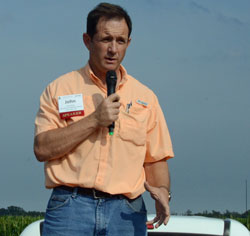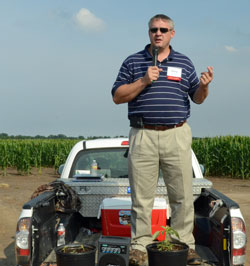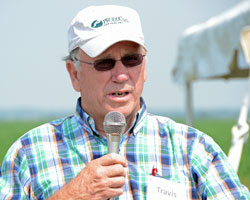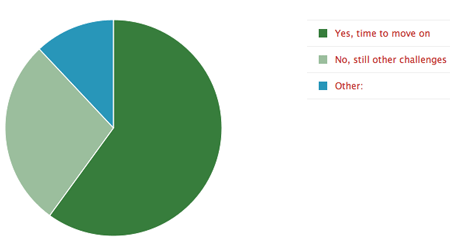 The International Society of Precision Agriculture just announced that the program is available for the upcoming 2012 International Conference on Precision Agriculture. This 11th edition of the conference will take place at the Hyatt Regency, Indianapolis, IN.
The International Society of Precision Agriculture just announced that the program is available for the upcoming 2012 International Conference on Precision Agriculture. This 11th edition of the conference will take place at the Hyatt Regency, Indianapolis, IN.
Precision agricultural techniques, technologies, and its applications continue to grow across the globe and so is the precision agricultural community. The 11th International Conference on Precision Agriculture is envisioned to be the largest ever; we anticipate over 600 attendees from all over the U.S and from over 50 countries.
Is your company interested in some great online exposure to the precision agriculture community? How about considering a sponsorship of our coverage of this year’s conference? For more details contact David Larson asap.
Crop Insurance Reporting with SMS

As crop insurance reporting deadlines near, farmers begin to prepare for this annual task and may find that using precision ag data can simplify the process. During planting season, growers are encouraged to use their Integra display from Ag Leader to record accurate planting data and then import this information into SMS software.
Once in SMS, reports can be created that include important insurance field details such as acres, dates and crops planted. With SMS, that planting information can be directly exported to a crop insurance provider.* The insurance provider can then import this data directly into their reporting system, often times pre-populating some of the required reports. Using SMS for crop insurance reporting is simple and saves time.
Watch more here.
*Contact the Ag Leader software support team to unlock this free tool at 515-232-5363.
Become a fan of Ag Leader on Facebook today, and get the latest precision ag videos on the YouTube channel. For more information about Ag Leader products and services, or to visit the blog site, go to www.agleader.com.
AgNerds Love Precision Agriculture
 We like new technology and we like our gadgets. We’re called AgNerds. And AgNerds are pretty open to precision agriculture. John McKee is one of us. John is a farmer of corn, cotton, soybeans and wheat. He was a civil engineer prior to farming so precision ag has come natural to him. He was also one of the speakers on the Conservation in Action Tour.
We like new technology and we like our gadgets. We’re called AgNerds. And AgNerds are pretty open to precision agriculture. John McKee is one of us. John is a farmer of corn, cotton, soybeans and wheat. He was a civil engineer prior to farming so precision ag has come natural to him. He was also one of the speakers on the Conservation in Action Tour.
He says the bottom line is “control.” He micro-manages every piece of his farm. He thinks it’s a good business plan. As he puts it, “We’re just able to put the medicine on the hurt place.” And that makes for a good conservation practice. He says that if the dirt and crop don’t need an input like nitrogen then “we certainly don’t want to put it there.” For one thing, it’s expensive. By being able to pull back with variable rate application it saves him on his pocketbook and the environment which is a win-win for everyone. He says equipment is getting better and cheaper but it needs to continue to get better and cheaper.
Listen to my interview with John here: [wpaudio url=”http://zimmcomm.biz/ctic/ctic-tour-12-mckee.mp3″ text=”Interview with John McKee”]
WANTED: On-the-Farm Conservation Stories
 U.S. soybean farmers are invited to tell the story of conservation on their farms by entering the 2012-2013 Conservation Legacy Awards. Winning entries will help tell the story to the public about how soybean farmers are committed to protecting the soil, water and air through outstanding environmental and conservation practices while continuing to farm profitably.
U.S. soybean farmers are invited to tell the story of conservation on their farms by entering the 2012-2013 Conservation Legacy Awards. Winning entries will help tell the story to the public about how soybean farmers are committed to protecting the soil, water and air through outstanding environmental and conservation practices while continuing to farm profitably.
Conservation Legacy Award winners from three regions (Midwest, Northeast and South) will each receive an expense-paid trip for two to the 2013 Commodity Classic convention and trade show, Feb. 28–March 2 in Kissimmee, Fla. Regional winners will also be showcased in video features focusing on their winning conservation practices. In addition, the regional winners will be featured in a special insert in Corn & Soybean Digest magazine.
One National Conservation Legacy Award winner will be chosen from the three regional winners and announced at the ASA Awards Banquet held during Commodity Classic.
All U.S. soybean farmers are eligible to enter. Applications must be submitted online by Aug. 6. Applications will be judged in five areas: soil management, water management, input management, farmstead protection, and conservation and environmental management.
Precision Ag in a Conservation Plan
 During the 2012 Conservation in Action Tour the word “precision” came up multiple times. As precision ag continues to develop it is being seen as an effective tool for conservation plans and practices. One of our speakers addressed this subject. He’s Terry Griffin, farmer and also VP, Applied Economics for new precision ag company, CrescoAg.
During the 2012 Conservation in Action Tour the word “precision” came up multiple times. As precision ag continues to develop it is being seen as an effective tool for conservation plans and practices. One of our speakers addressed this subject. He’s Terry Griffin, farmer and also VP, Applied Economics for new precision ag company, CrescoAg.
Terry says one example of how farmers are using precision ag to enhance conservation is applying nutrients where the truth is often the opposite of what some non-farmers may think. With precision equipment and applications farmers are applying appropriate rates to the appropriate place at the appropriate time. He says farmer are trying to maximize profits and that can’t happen by over applying inputs like fertilizer.
Listen to my interview with Terry here: [wpaudio url=”http://zimmcomm.biz/ctic/ctic-tour-12-griffin.mp3″ text=”Interview with Terry Griffin”]
Land Forming For Sustainable Water Conservation
 Last week I attended the 2012 Conservation in Action Tour courtesy of AGROTAIN. I’m going to share some of my stories here like this one with one of the speakers on the annual tour.
Last week I attended the 2012 Conservation in Action Tour courtesy of AGROTAIN. I’m going to share some of my stories here like this one with one of the speakers on the annual tour.
Travis Satterfield grows mainly rice and soybeans in Mississippi. He has also served as Chair of Delta F.A.R.M. and is a member of the Mississippi Delta Sustainable Water Resources Task Force. I visited with him during the 2012 Conservation in Action Tour.
He got involved in the tour because of his concern about the availability and quality of water and the need to be a good steward of the land. Travis is a great example of a farmer who cares about his land. He has sons that he wants to be able to turn the farm over to and therefore he believes it’s important to practice good conservation so it will be there for them. I asked him about the task force he is a member of. He says it was formed to bring together all the organizations involved in Delta region conservation to address actionable approaches to solving water problems. One of those approaches he’s using on his farm is land forming.
Listen to my interview with Travis here: [wpaudio url=”http://zimmcomm.biz/ctic/ctic-tour-12-satterfield.mp3″ text=”Travis Satterfield Interview”]
Most Think Atrazine Settlement Good For Farmers
Our latest ZimmPoll asked the question, “Is Atrazine lawsuit settlement good for farmers?” We posed this question after a lawsuit against Syngenta related to the herbicide was settled with an offer of over $100 million by the company, even thought there has been no evidence of harm in drinking water caused by the product and the plaintiffs in the lawsuit acknowledged they had not commissioned any research on the subject or seen any new research to the contrary either.
Our poll results: Sixty percent said Yes, time to move on; twenty eight percent said No, still other challenges and twelve percent chose Other.
Our new ZimmPoll is now live and asks the question, “Do you prefer corn sugar to high fructose corn syrup?” Recently the FDA denied a request from the Corn Refiners Association to allow food labels to use the term corn sugar instead of high fructose corn syrup. Nutritionally, there is no difference in regular table sugar and HFCS so I don’t see why FDA ruled like they did. There reasoning had to do with their definition of sugar as a crystalline solid. This is basically a public relations war over words since the “problem” with both substances is how much someone consumes. Nothing wrong with cane sugar or corn sugar in my opinion. I like them both. Apparently consumers like HFCS better according to this story. What do you think?
![]() ZimmPoll is sponsored by Rhea+Kaiser, a full-service advertising/public relations agency.
ZimmPoll is sponsored by Rhea+Kaiser, a full-service advertising/public relations agency.
In-Season Satellite Technology Now Available
 The latest satellite images of specific fields—combined with pertinent agronomic data—are now available to farmers and their retail partners to optimize the in-season decisions they make. The images are powered by new, exclusive technology from GEOSYS that arms retailers with the latest data to make decisions, such as determining appropriate crop protection and nutrient application, as focused and efficient as possible.
The latest satellite images of specific fields—combined with pertinent agronomic data—are now available to farmers and their retail partners to optimize the in-season decisions they make. The images are powered by new, exclusive technology from GEOSYS that arms retailers with the latest data to make decisions, such as determining appropriate crop protection and nutrient application, as focused and efficient as possible.
The technology helps retailers and agronomists better identify areas of a field that require immediate attention to protect yields for their farmers. The remote field scouting tool uses the latest innovative GEOSYS technology to deliver these current satellite images throughout the growing season, and automatically distributes email alerts when new field images are added.
Available through a secure website, the up-to-date images can be converted into application maps using the most advanced agronomic models and geographic information systems to help farmers manage variations within their specific fields. During the 2012 crop year, the service is available exclusively through WinField Solutions.
Maximizing Yields in Corn-on-Corn
 As the economics of corn drive more farmers to move toward corn-on-corn production, they are often faced with additional challenges not typically encountered in a traditional corn-soybean rotation. In order to maximize the potential for high yields in corn-on-corn, farmers need to focus on several agronomic factors.
As the economics of corn drive more farmers to move toward corn-on-corn production, they are often faced with additional challenges not typically encountered in a traditional corn-soybean rotation. In order to maximize the potential for high yields in corn-on-corn, farmers need to focus on several agronomic factors.
This summer in heavy corn rootworm pressure areas Monsanto plans to host a number of corn-on-corn clinics focusing on some of the agronomic factors associated with corn-on-corn production. Agronomic factors that need to be considered in corn-on-corn production include, but are not limited to, residue management, seedbed preparation, soil fertility, weed control, disease pressure and insect pressure.
Because every field is unique, growers are encouraged to carefully evaluate the emergence scores, disease tolerance and insect protection component of each corn hybrid when making selections for corn-on-corn acres.
Hybrids incorporating Bt proteins for insect protection and traits to provide herbicide tolerance have been shown to help alleviate the stresses that the environment places on corn-on-corn production. Healthier plants can withstand greater environmental stress, which typically results in higher yields.
Insect control is particularly key, and a critical pest in corn-on-corn production is corn rootworm. And, Scouting is an integral part of insect management.
Little Things Make a Big Difference During Planting

Will Cannon, Ag Leader Product Specialist for SeedCommand, says, “There are 100 ways to farm and 99 of them work; but it’s adding up all of the little things that you do together that can make a big difference.” Available from Ag Leader for the 2013 spring planting season is the Ag Leader Hydraulic Down Force, or how you maintain optimal down force from your planter so you get the best seed-to-soil contact across your field at planting time.
Farmers all know the soil and terrain across a field can vary significantly. But when it’s time to roll the planter through the field, properly controlling planter down force is critical to your yield and your pocketbook.
“As terrain and soil changes cause the gauge wheels to sense more or less down force, the hydraulics adjust instantly, ensuring that the planter maintains the proper planting down force – without the ramping affect that the air bag systems experience. The result? More consistent seed depth with minimal seed trench compaction across the field,” says Cannon.
[wpaudio url=”http://precision.agwired.com/wp-content/uploads/sites/3/2012/05/WillC1.mp3″ text=”Listen to Cannon explain”]What sets the Ag Leader Hydraulic Down Force apart from its competitors is that it’s hydraulically-powered. That means it senses and responds to soil and terrain changes almost instantly. As soon as the gauge wheels indicate that the planter section needs more or less pressure, the hydraulic actuator responds completely – within one second.
[wpaudio url=”http://precision.agwired.com/wp-content/uploads/sites/3/2012/05/WillC2.mp3″ text=”Listen to Cannon explain”]Some studies show that not planting at the proper depth across the field can equate to 10 to 15 bushels per acre in yield loss. And that doesn’t even account for the cost of the seed or other inputs. Cannon puts this in “real experience” terms.
[wpaudio url=”http://precision.agwired.com/wp-content/uploads/sites/3/2012/05/WillC3.mp3″ text=”Listen to Cannon explain”]And, another benefit to the Ag Leader Hydraulic Down Force is that it has two channels of control on it. Thus, it measures and adjusts down force by planter section, allowing the system to adjust the down force separately across different parts of the planter. That means more consistent planting depth across the entire planter.
[wpaudio url=”http://precision.agwired.com/wp-content/uploads/sites/3/2012/05/WillC4.mp3″ text=”Listen to Cannon explain”]The attachment will go right on the planter and will be available for purchase this fall for John Deere and Kinze planters for use in the spring of 2013.
Become a fan of Ag Leader on Facebook today, and get the latest precision ag videos on the YouTube channel. For more information about Ag Leader products and services, or to visit the blog site, go to www.agleader.com.

